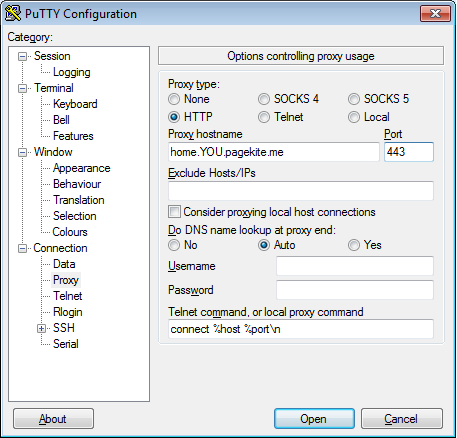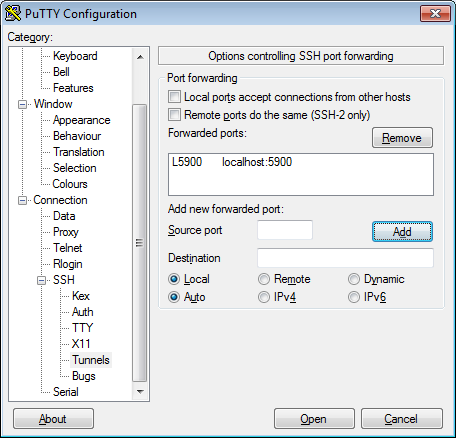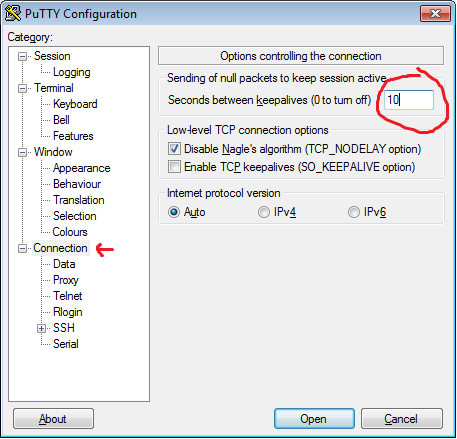Using PuTTY to create SSH tunnels with PageKite
PageKite supports tunneling SSH connections. This means that you can use pagekite.py to create a tunnel for ssh just like for web servers.
PuTTY is a nice Windows ssh client. PuTTY supports the proxy connect method that is needed to be able to use ssh over pagekite.
It is assumed in this HowTo that you have exposed an SSH server running on the same machine as pagekite.py with a backend command like:
$ pagekite.py 22 ssh:home.YOU.pagekite.me
Or a line like this in your configuration file:
backend=raw/22:home.YOU.pagekite.me:localhost:22:S3Cr37
Set up a PuTTY session
Lets assume you are running an ssh server on the backend you've made accessible from the name home.YOU.pagekite.me. Create a session for it in the PuTTY session dialog and save it under a name, here Home.

Before you can connect to the SSH backend you have to specify that you want to have PuTTY connect through a proxy.
On the right in the PuTTY session dialog you can select Proxy. There you specify that you want to use the HTTP proxy method. The proxy hostname should be set to the pagekite name, here home.YOU.pagekite.me, port 443.

Go back to the Session dialog and save this under Home (or the session name you chose).
Try using this session to connect to your SSH kite and verify it is working.
Using PuTTY/SSH to create TCP tunnels
SSH can be used to tunnel any TCP based port/protocol through the SSH connection. This means that once you have set up a SSH/PageKite connection as described above you can tunnel any TCP connection through it.
The VNC remote desktop protocol is often used through SSH tunnels. This is a great way to access your desktop at home from anywhere!
The default port for VNC is 5900. To access a VNC shared desktop on your backend SSH server from the machine you are running PuTTY on you simply need to forward port 5900 on the backend to port 5900 on the PuTTY machine. This is easy to do in the SSH/Tunnel dialog in PuTTY.
Set source port to 5900 and destination to localhost:5900. This means forward port 5900 on the PuTTY machine (source port) to port 5900 on the machine running the backend (localhost seen from the backend).

A good VNC client for windows to use with this setup is TightVNC. Simply use the VNC client to connect to localhost. The connection to port 5900 on the PuTTY machine will be forwarded to port 5900 on the SSH server backend.
To get the best performance you should experiment with VNC encodings. The author of this HowTo has had good success with the Hextile encoding and 8bit color.
Troubleshooting
SSH disconnects if idle
Some firewalls seem to disconnect sessions when there is no activity. You can instruct PuTTY to send empty data packets at an interval to make it look like the connection is active. Go into the Connection entry in the the PuTTY setup and set "Second between keepalives" to something larger than zero.

[ Wiki home ]




Comments
Normally I have no problem to connect via ssh and pagekite to my server but it is not possiblke for me if I try to do it from Intranet (for example there is Internet Explorer configured to use proxy on dedicated port and if I try to open page I have to use my Windows username and password. I try to connect to my server sia Putty and pagekite but in this environment it is not possible. I think I should Putty's Connection -> Proxy tab fill using my intranet proxy and port, byt according to manual above I have to put there home.YOU.pagekite.me, port 443. So it is not possible to use this LAN proxy settings. Is it possible to connect in any way to my server from this LAN where I have tu use proxy even to web browsing?